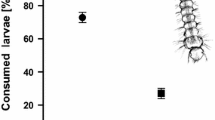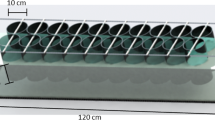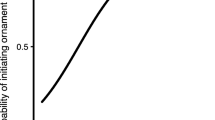Abstract
The competitive environment that animals experience during development constitutes an important source of selection that can influence the development, expression and evolution of traits. Here, we examine how the sex of focal and “competitor” individuals interact to affect development in the Eastern mosquitofish Gambusia holbrooki. We raised individuals of both sexes either alone or in the presence of a male or female conspecific (hereafter “competitor”), and measured their juvenile growth rate, time to maturity and size at maturity. For males, we also measured their gonopodium length, sperm quantity, and sperm velocity. We found that responses to the competitive environment were dependent on the sex of the focal individual, the sex of their “competitor” and sometimes an interaction between the two. When there was another fish present, regardless of its sex, males had slower growth rates and took longer to mature, but eventually matured at the same size. Females also showed slower growth rates in the presence of a competitor, but in contrast to males, reached maturity sooner and at a smaller size than when there was no competitor present. Presence of a competitor influenced male sexual traits, however there was little evidence that these effects were mediated by the sex of the other fish. Males reared with another fish had longer gonopodia for their body size, as well as fewer and faster sperm. Our results suggest that effects of the competitive environment are different for males and females, potentially due to sex differences in adult life history strategies. Further, for males, both life history traits and sexual traits were influenced by the competitive environment. For life history traits this effect appears to result from decreased resources and/or increased energy expenditure, but for sexual traits, effects appear to be mediated, in part, by the social environment.




Similar content being viewed by others
Data availability
All data will be published on DRYAD and is available for reviewers at https://datadryad.org/stash/share/lNz54rPe9ZnLwzDCXDWywb8s0cSWJfPsJse4O0gUOWU.
References
Abràmoff MD, Magalhães PJ, Ram SJ (2004) Image processing with imageJ. Biophoton Int 11(7):36–41
Badyaev AV (2002) Growing apart: an ontogenetic perspective on the evolution of sexual size dimorphism. Trends Ecol Evol 17(8):369–378
Bedhomme S, Agnew P, Sidobre C, Michalakis Y (2003) Sex-specific reaction norms to intraspecific larval competition in the mosquito Aedes aegypti. J Evol Biol 16(4):721–730
Bisazza A, Marin G (1995) Sexual selection and sexual size dimorphism in the eastern mosquitofish Gambusia holbrooki (Pisces Poeciliidae). Ethol Ecol Evol 7(2):169–183
Bisazza A, Pilastro A, Palazzi R, Marin G (1996) Sexual behaviour of immature male eastern mosquitofish: A way to measure intensity of intra-sexual selection? J Fish Biol 48(4):726–737
Bisazza A, Vaccari G, Pilastro A (2001) Female mate choice in a mating system dominated by male sexual coercion. Behav Ecol 12(1):59–64
Bolker BM, Brooks ME, Clark CJ, Geange SW, Poulsen JR, Stevens MHH, White J-SS (2009) Generalized linear mixed models: a practical guide for ecology and evolution. Trends Ecol Evol 24:127–135
Bonin MC, Boström-Einarsson L, Munday PL, Jones GP (2015) The prevalence and importance of competition among coral reef fishes. Annu Rev Ecol Evol Syst 46(1):169–190
Bonisoli-Alquati A, Boncoraglio G, Caprioli M, Saino N (2011) Birth order, individual sex and sex of competitors determine the outcome of conflict among siblings over parental care. Proc R Soc B Biol Sci 278(1709):1273–1279
Bonneaud C, Marnocha E, Herrel A, Vanhooydonck B, Irschick DJ, Smith TB (2016) Developmental plasticity affects sexual size dimorphism in an anole lizard. Funct Ecol 30(2):235–243
Borowsky RL (1973) Social control of adult size in males of Xiphophorus variatus. Nature 245:333–335
Bretman A, Gage MJG, Chapman T (2011) Quick-change artists: male plastic behavioural responses to rivals. Trends Ecol Evol 26(9):467–473
Butler DG, Cullis BR, Gilmour AR, Gogel BJ, Thompson R (2017) ASReml-R Reference manual, version 4. VSN International Ltd, Hemel Hempstead
Byrne M, Ho M, Selvakumaraswamy P, Nguyen HD, Dworjanyn SA, Davis AR (2009) Temperature, but not pH, compromises sea urchin fertilization and early development under near-future climate change scenarios. Proc R Soc B Biol Sci 276:1883–1888
Croft DP, Albanese B, Arrowsmith BJ, Botham M, Webster M, Krause J (2003) Sex-biased movement in the guppy (Poecilia reticulata). Oecologia 137(1):62–68
Engqvist L (2005) The mistreatment of covariate interaction terms in linear model analyses of behavioural and evolutionary ecology studies. Anim Behav 70(4):967–971
Fischer K, Bot ANM, Brakefield PM, Zwaan BJ (2003) Fitness consequences of temperature-mediated egg size plasticity in a butterfly. Funct Ecol 17:810
Frommen JG, Hanak S, Schmidl CA, Thünken T (2015) Visible implant elastomer tagging influences social preferences of Zebrafish (Danio Rerio). Behaviour 152(12–13):1765–1777
Head ML, Kahn AT, Henshaw JM, Keogh JS, Jennions MD (2017) Sexual selection on male body size, genital length and heterozygosity: consistency across habitats and social settings. J Anim Ecol 86:1458–1468
Hohn C, Petrie-Hanson L (2013) Evaluation of visible implant elastomer tags in zebrafish (Danio rerio). Biol Open 2(12):1397–1401
Iguchi K (1996) Sexual asymmetry in competitive ability in the immature ayu. J Ethol 14:53–58
Kolluru GR, Reznick DN (1996) Genetic and social control of male maturation in Phallichthys quadripuntatus (pisces: poeciliidae). J Evol Biol 9:695–715
Livingston JD, Kahn AT, Jennions MD (2014) Sex differences in compensatory and catch-up growth in the mosquitofish Gambusia holbrooki. Evol Ecol 28(4):687–706
Magellan K, Magurran AE (2009) the effect of social environment during ontogeny on life history expression in the guppy Poecilia reticulata. J Fish Biol 74:2329–2337
Magurran A, Garcia CM (2002) Sex differences in behaviour as an indirect consequence of mating system. J Fish Biol 57(4):839–857
Mautz BS, Jennions MD (2011) The effect of competitor presence and relative competitive ability on male mate choice. Behav Ecol 22(4):769–775
Mayntz D, Toft S, Vollrath F (2003) Effects of prey quality and availability on the life history of a trap-building predator. Oikos 101:631–638
Mcpeek MA (1992) Mechanisms of sexual selection operating on body size in the mosquitofish (Gambusia holbrooki). Behav Ecol 3(1):1–12
Meffe G (1992) Plasticity of life-history characters in Eastern Mosquitofish (Gambusia holbrooki: Poeciliidae) in response to thermal stress. Copeia 1992(1):94–102
Nicolaus M, Michler SPM, Ubels R, van der Velde M, Komdeur J, Both C, Tinbergen JM (2009) Sex-specific effects of altered competition on nestling growth and survival: an experimental manipulation of brood size and sex ratio. J Anim Ecol 78(2):414–426
O’Dea RE, Jennions MD, Head ML (2014) Male body size and condition affects sperm number and production rates in mosquitofish, Gambusia holbrooki. J Evol Biol 27(12):2739–2744
Oddie KR (2000) Size matters: competition between male and female great tit offspring. J Anim Ecol 69:903–912
Pilastro A, Benetton S, Bisazza A (2003) Female aggregation and male competition reduce costs of sexual harassment in the mosquitofish Gambusia holbrooki. Anim Behav 65(6):1161–1167
Pyke GH (2005) A review of the biology of Gambusia affinis and G. holbrooki. Rev Fish Biol Fish 15(4):339–365
Relyea RA (2004) Fine-tuned phenotypes: tadpole plasticity under 16 combinations of predators and competitors. Ecology 85:172–179
Sadoul B, Vijayan MM (2016) Stress and Growth. In: Schreck CB, Tort L, Farrell AP, Brauner CJ (eds) Fish Physiology, Vol 35, Chapt 5. Academic Press, pp 167–205
Spagopoulou F, Vega-Trejo R, Head ML, Jennions MD (2020) Shifts in reproductive investment in response to competitors lower male reproductive success. Am Nat 196(3):355–368
Stillwell RC, Blanckenhorn WU, Teder T, Davidowitz G, Fox CW (2010) Sex differences in phenotypic plasticity affect variation in sexual size dimorphism in insects: from physiology to evolution. Annu Rev Entomol 55(1):227–245
Uller T (2006) Sex-specific sibling interactions and offspring fitness in vertebrates: patterns and implications for maternal sex ratios. Biol Rev Camb Philos Soc 81(2):207–217
Varga S, Kytöviita MM (2012) Differential competitive ability between sexes in the dioecious Antennaria dioica (Asteraceae). Ann Bot 110:1461–1470
Vega-Trejo R, Jennions MD, Head ML (2016) Are sexually selected traits affected by a poor environment early in life? BMC Evol Biol 16(1):1–12
Vega-Trejo R, Head ML, Keogh JS, Jennions MD (2017) Experimental evidence for sexual selection against inbred males. J Anim Ecol 86(2):394–404
Vega-Trejo R, Fox RJ, Iglesias-Carrasco M, Head ML, Jennions MD (2019) The effects of male age, sperm age and mating history on ejaculate senescence. Funct Ecol 33:1–13
Walling CA, Royle NJ, Metcalfe NB, Linström J (2007) Green swordtails alter their age at maturation in response to the population level of male ornamentation. Biol Let 3:144–146
Wikelski M, Thom C (2000) Marine iguanas shrink to survive El Niño. Nature 403(6765):37–38
Zulian E, Bisazza A, Marin G (1995) Variations in male body size in natural populations of gambusia holbrooki. Ethol Ecol Evol 7(1):1–10
Acknowledgements
We thank the ANU animal services team for help with fish maintenance. Funding for this project was provided by the Australian Research Council (FT160100149 to MLH and FT110100453 to LEBK). We are grateful to Michael Jennions for discussions, and to Alastair Wilson, Kit Magellan and two anonymous referees for comments on the manuscript.
Author information
Authors and Affiliations
Contributions
SB, LEBK and MLH conceived the ideas and designed the methodology; SB collected the data; SB, LEBK and MLH analysed the data, SB and MI-C led the writing of the manuscript. All authors contributed critically to drafts and gave final approval for publication.
Corresponding author
Ethics declarations
Conflict of interest
The authors have no conflict of interest to declare.
Additional information
Publisher's Note
Springer Nature remains neutral with regard to jurisdictional claims in published maps and institutional affiliations.
Electronic supplementary material
Below is the link to the electronic supplementary material.
Rights and permissions
About this article
Cite this article
Brookes, S., Iglesias-Carrasco, M., Kruuk, L.E.B. et al. Sex-specific responses to competitive environment in the mosquitofish Gambusia holbrooki. Evol Ecol 34, 963–979 (2020). https://doi.org/10.1007/s10682-020-10080-y
Received:
Accepted:
Published:
Issue Date:
DOI: https://doi.org/10.1007/s10682-020-10080-y




